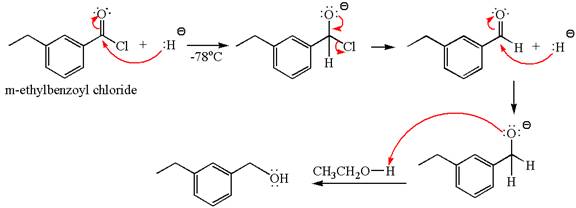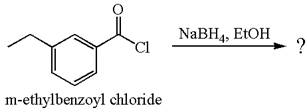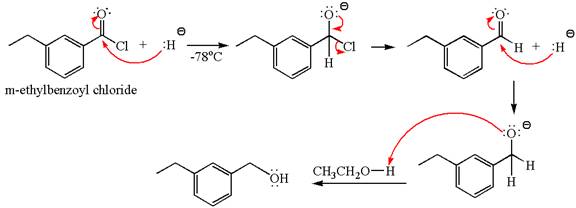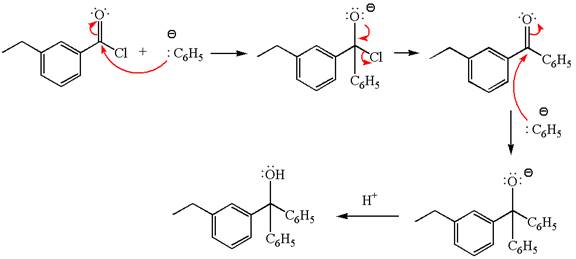
Concept explainers
(a)
Interpretation:
The product with detailed mechanism for the reaction between
Concept introduction:
An acid chloride can be converted to corresponding
Answer to Problem 20.45P
The product with detailed mechanism for the reaction between

Explanation of Solution
The equation for the reaction of


The product with detailed mechanism for the given reaction is drawn based on the reactivity of
(b)
Interpretation:
The product with detailed mechanism for the reaction between
Concept introduction:
An acid chloride can be converted to an
Answer to Problem 20.45P
The product with detailed mechanism for the reaction between

Explanation of Solution
The equation for the reaction of


The product with detailed mechanism for the given reaction is drawn based on the reactivity of
(c)
Interpretation:
The product with detailed mechanism for the reaction between
Concept introduction:
An acid chloride can be converted to a primary alcohol by reacting with
Answer to Problem 20.45P
The product with detailed mechanism for the reaction between

Explanation of Solution
The equation for the reaction of


The product with detailed mechanism for the given reaction is drawn based on the reactivity of
(d)
Interpretation:
The product with detailed mechanism for the reaction between
Concept introduction:
An acid chloride can be converted to a tertiary alcohol by reacting it with
Answer to Problem 20.45P
The product with detailed mechanism for the reaction between

Explanation of Solution
The equation for the reaction of


The product with detailed mechanism for the given reaction is drawn based on the reactivity of
Want to see more full solutions like this?
Chapter 20 Solutions
Organic Chemistry: Principles and Mechanisms (Second Edition)
- 6.15PM Sun Mar 30 K Draw the major product of this reaction. Include any relevant stereochemistry. Ignore inorganic byproducts. Problem 1 of O H [PhзPCH2CH3]*C|¯ NaH Drawing > Q Atoms, Bonds and Draw or tap a nearrow_forward8:17 PM Sun Mar 30 Draw the major product of this reaction. Ignore inorganic byproducts. HSCH2CH2CH2SH, BF3 Probler Drawing Ato Bonds Clarrow_forwardpresented by Mr L How the coprion. (Il Done in no wraction, dew the starting redential) доarrow_forward
- 8:16 PM Sun Mar 30 K Draw the major product of this reaction. Ignore inorganic byproducts. Proble 1. CH3MgBr 2. H3O+ F Drawingarrow_forwardо но оarrow_forwardName the major organic product of the following action of 4-chloro-4-methyl-1-pentanol in neutral pollution 10+ Now the product. The product has a molecular formula f b. In a singly hain, the starting, material again converts into a secule with the molecular kormula CIO. but with comply Draw the major organic structure inhalationarrow_forward
- Macmillan Learning Alcohols can be oxidized by chromic acid derivatives. One such reagent is pyridinium chlorochromate, (C,H,NH*)(CICTO3), commonly known as PCC. Draw the proposed (neutral) intermediate and the organic product in the oxidation of 1-butanol by PCC when carried out in an anhydrous solvent such as CH₂C₁₂. PCC Intermediate OH CH2Cl2 Draw the intermediate. Select Draw Templates More с H Cr о Product Draw the product. Erase Select Draw Templates More H о Erasearrow_forwardIf I have 1-bromopropene, to obtain compound A, I have to add NaOH and another compound. Indicate which compound that would be. A C6H5 CH3arrow_forwardProvide the reagents for the following reactions.arrow_forward
- If I have 1-bromopropene, to obtain compound Z, I have to add two compounds A1 and A2. Indicate which compounds are needed. P(C6H5)3arrow_forwardDraw the major product of this reaction. Ignore inorganic byproducts. Assume that the water side product is continuously removed to drive the reaction toward products. O CH3CH2NH2, TSOH Select to Draw >arrow_forwardPredict the major organic product(s) for the following reaction.arrow_forward
